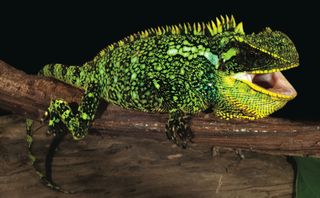Here Be Dragons: 3 Spiky Lizard Species Found in Andes

Colorful, spiky and only a few inches long, three new lizard species discovered in the Andes may be the cutest dragon stand-ins on Earth.
Woodlizards are often described as miniature dragons because of their probing eyes, richly patterned skin and rows of spikelike scales. Until now, only 12 species of the genus Enyalioides were known, and five of those were discovered in just the past seven years.
The three new species were found in the cloud forests of Peru and Ecuador, an international research team reported today (April 6) in the journal ZooKeys. These high-altitude tropical forests are permanently shrouded in fog and mist, creating an otherworldly environment that abounds in biological diversity. [In Photos: Life Up in the Clouds]
The team, led by Omar Torres-Carvajal of the Museo de Zoología QCAZ in Ecuador, also ferreted out the five other woodlizard species recorded in recent years. "The diversity of these conspicuous reptiles has been underestimated," Torres-Carvajal said in a statement.

Woodlizards grow to be between 3 and 6 inches (7 to 15 centimeters) long, making them one of the largest lizards in the Amazon rainforest. The lizards' colors and patterns help them blend into the environment, the researchers said.
Each of the three new species differs from its relatives by body characteristics such as color, scale shape and size, as well as their mitochondrial DNA, the study reported.
The scientists named one of the new lizards E. sophiarothschildae, after Sophia Rothschild, a donor to Germany's BIOPAT program. (BIOPAT donors get to suggest names for newly discovered plant and animal species.)
Sign up for the Live Science daily newsletter now
Get the world’s most fascinating discoveries delivered straight to your inbox.
The new woodlizard was discovered in the upper basin of the Huallaga River at 4,921 feet (1,500 meters) elevation in northern Peru. It has a greenish-black back with olive flecks, and a conspicuous white patch on its throat. Huge scales trail down its spine.

The other newly described lizards are E. anisolepis and E. altotambo. The 5-inch-long (13 cm) lizard E. anisolepis is named for a Greek word that means unequal scales, which refers to the differently sized scales on its back, flanks and limbs. This scaly lizard also has conical spikes sticking out of the back of its head. Males are black and green, and females are speckled pale brown. The species lives in both northern Peru and southern Ecuador between 2,375 feet and 5,715 feet (724 and 1742 m) above sea level.
Finally, E. altotambo refers to the town of Alto Tambo, Ecuador, where this bright-green lizard was found. Both males and females closely resemble the thick-necked, warty dragon called "Gronckle" from the 2010 film "How to Train Your Dragon." The new species also looks like another woodlizard, named E. oshaughnessyi, but the close cousins' irises differ in color — one species has coffee-brown eyes, and the other species' eyes are an evil red. Also, E. altotambo's scales are all the same size, the study reported. E. oshaughnessyi has progressively smaller scales marching down its back.
Follow Becky Oskin @beckyoskin. Follow Live Science @livescience, Facebook & Google+. Originally published on Live Science.

